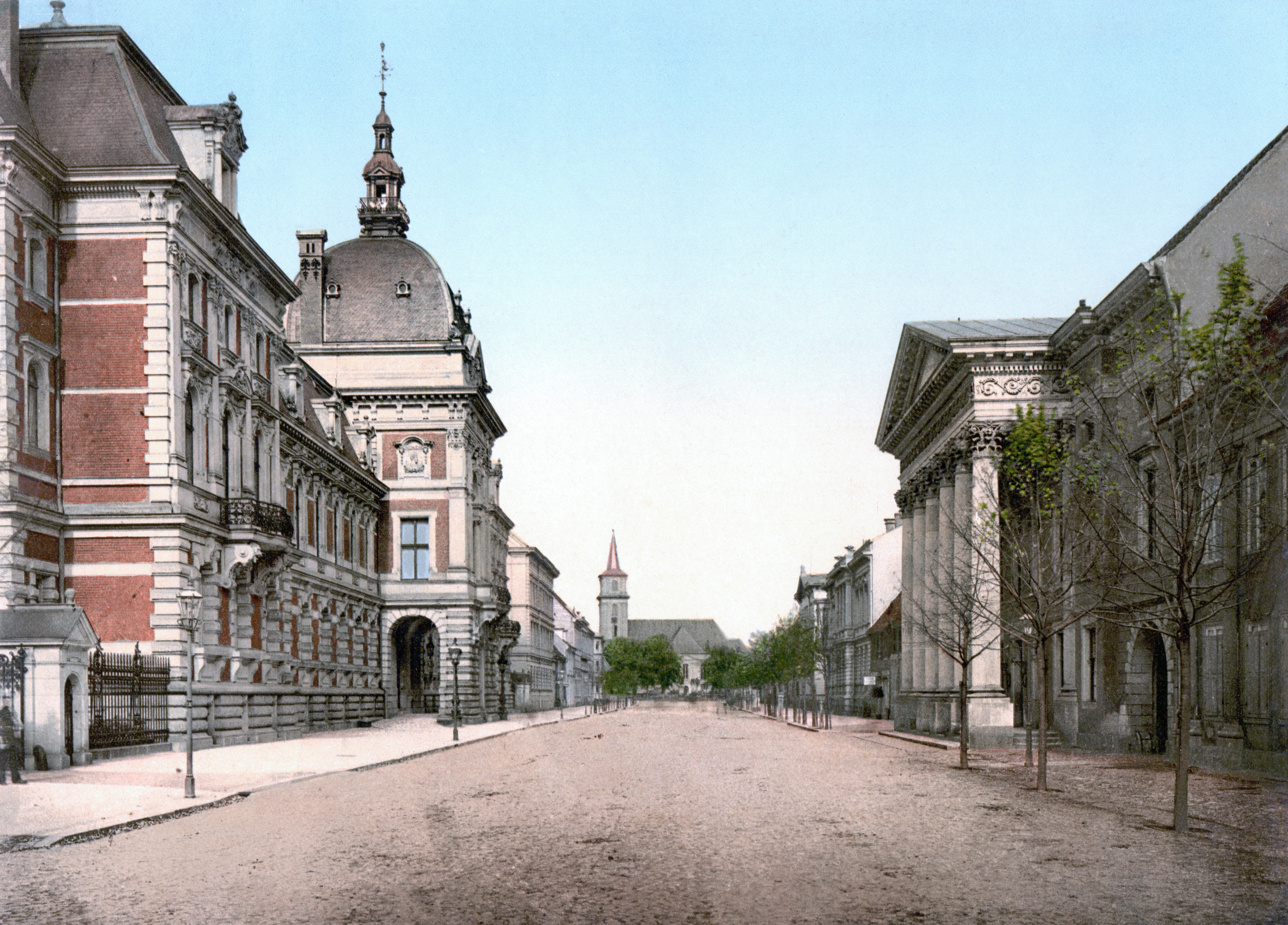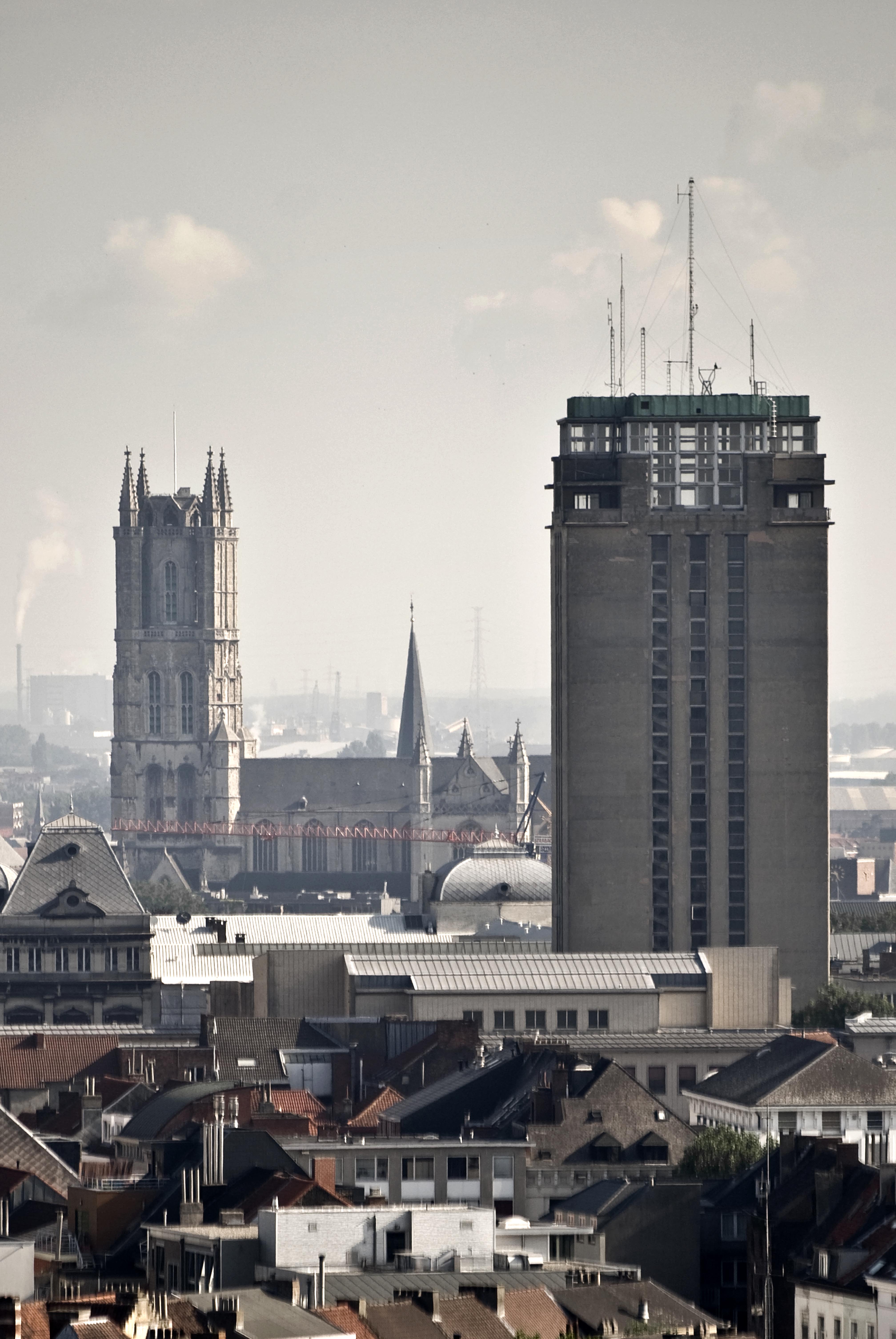|
Bauhaus Dessau
Bauhaus Dessau, also Bauhaus-Building Dessau, is a building-complex in Dessau-Roßlau. It is considered the pinnacle of pre-war modern design in Europe and originated out of the dissolution of the Weimar School and the move by local politicians to reconcile the city's industrial character with its cultural past. The building was constructed between 1925 and 1926 according to plans by Walter Gropius as a school building for the Bauhaus School of Art, Design and Architecture. The building itself and the Masters' Houses that were built in the immediate vicinity established the reputation of the Bauhaus as an "icon of modernism". War-damaged and structurally altered sections were largely reconstructed from 1965 onwards in the spirit of the original. The building was restored and partially modernized in 1976. Between 1996 and 2006, the building was restored and repaired in accordance with the principles of historical preservation. Since 1996, the building complex has been part o ... [...More Info...] [...Related Items...] OR: [Wikipedia] [Google] [Baidu] |
Dessau Bauhaus Neu
Dessau is a town and former municipality in Germany at the confluence of the rivers Mulde and Elbe, in the ''States of Germany, Bundesland'' (Federal State) of Saxony-Anhalt. Since 1 July 2007, it has been part of the newly created municipality of Dessau-Roßlau. Population of Dessau proper: 67,747 (Dec. 2020). Geography Dessau is situated on a floodplain where the Mulde flows into the Elbe. This causes yearly floods. The worst flood took place in the year 2002, when the Waldersee district was nearly completely flooded. The south of Dessau touches a well-wooded area called Mosigkauer Heide. The highest elevation is a 110 m high former rubbish dump called Scherbelberg in the southwest of Dessau. Dessau is surrounded by numerous parks and palaces that make it one of the greenest towns in Germany. History Dessau was first mentioned in 1213. It became an important centre in 1570, when the Principality of Anhalt was founded. Dessau became the capital of this state within the Holy ... [...More Info...] [...Related Items...] OR: [Wikipedia] [Google] [Baidu] |
Marcel Breuer
Marcel Lajos Breuer ( ; 21 May 1902 – 1 July 1981), was a Hungarian-born modernist architect and furniture designer. At the Bauhaus he designed the Wassily Chair and the Cesca Chair, which ''The New York Times'' have called some of the most important chairs of the 20th century. Breuer extended the sculpture vocabulary he had developed in the carpentry shop at the Bauhaus into a personal architecture that made him one of the world's most popular architects at the peak of 20th-century design. His work includes art museums, libraries, college buildings, office buildings, and residences. Many are in a Brutalist architecture style, including the former IBM Research and Development facility which was the birthplace of the first personal computer. He is regarded as one of the great innovators of modern furniture design and one of the most-influential exponents of the International Style. Life, work and inventions Commonly known to his friends and associates as Lajkó ( ; the dimin ... [...More Info...] [...Related Items...] OR: [Wikipedia] [Google] [Baidu] |
Rowac Anzeige Im Bauhaus Dessau Prospekt
Rowac (acronym for Robert Wagner Chemnitz) was a hardware factory founded by Carl Robert Wagner in 1888 in Chemnitz, Germany which most notably produced furniture for industrial use. Carl Robert Wagner is regarded as the inventor of the steel stool, which among other things was chosen for the workshops and classrooms of the Bauhaus Dessau. Today, mainly stools, chairs and cabinets carrying the Rowac name are traded as antiques. History From foundation to fast–growing company (1888–1904) On May 11, 1888, Carl Robert Wagner founded the Hardware Factory Robert Wagner Chemnitz, abbreviated Rowac, with the company located in the Zschopauer Straße in Chemnitz, Germany.Stadtarchiv, Historisches Archiv, Aue 16, 09112 Chemnitz The company was entered in the commercial register on March 9, 1895. Carl Robert Wagner embarked on his entrepreneurial career with the production of mass-produced products made of steel and wood, such as a wide range of closures and fittings for win ... [...More Info...] [...Related Items...] OR: [Wikipedia] [Google] [Baidu] |
Dessau
Dessau is a town and former municipality in Germany at the confluence of the rivers Mulde and Elbe, in the '' Bundesland'' (Federal State) of Saxony-Anhalt. Since 1 July 2007, it has been part of the newly created municipality of Dessau-Roßlau. Population of Dessau proper: 67,747 (Dec. 2020). Geography Dessau is situated on a floodplain where the Mulde flows into the Elbe. This causes yearly floods. The worst flood took place in the year 2002, when the Waldersee district was nearly completely flooded. The south of Dessau touches a well-wooded area called Mosigkauer Heide. The highest elevation is a 110 m high former rubbish dump called Scherbelberg in the southwest of Dessau. Dessau is surrounded by numerous parks and palaces that make it one of the greenest towns in Germany. History Dessau was first mentioned in 1213. It became an important centre in 1570, when the Principality of Anhalt was founded. Dessau became the capital of this state within the Holy Roman Empire. In ... [...More Info...] [...Related Items...] OR: [Wikipedia] [Google] [Baidu] |
Grand-Ducal Saxon Art School, Weimar
The Grand-Ducal Saxon Art School, Weimar (German:Großherzoglich-Sächsische Kunstschule Weimar) was founded on 1 October 1860, in Weimar, Germany, by a decree of Charles Alexander, Grand Duke of Saxe-Weimar-Eisenach. It existed until 1910, when it merged with several other art schools to become the ''Großherzoglich Sächsische Hochschule für Bildende Kunst'' ("Grand-Ducal Saxon School for Fine Arts"). It should not be confused with the Weimar Princely Free Drawing School, which existed from 1776 to 1930 and, after 1860, served as a preparatory school. History From 1870 to 1900, the students and teachers of the school turned away from the academic tradition of idealized compositions. Inspired by the Barbizon School, they went directly to nature for their inspiration, in genre as well as landscape painting. This approach set the school apart and attracted attention throughout Europe. Grand-Ducal Saxon School for Fine Arts, Weimar In 1910, William Ernest, Grand Duke of Saxe-Weimar ... [...More Info...] [...Related Items...] OR: [Wikipedia] [Google] [Baidu] |
Henry Van De Velde
Henry Clemens van de Velde (; 3 April 1863 – 15 October 1957) was a Belgian painter, architect, interior designer, and art theorist. Together with Victor Horta and Paul Hankar, he is considered one of the founders of Art Nouveau in Belgium.'''' He worked in Paris with Samuel Bing, the founder of the first gallery of Art Nouveau in Paris. Van de Velde spent the most important part of his career in Germany and became a major figure in the German Jugendstil. He had a decisive influence on German architecture and design at the beginning of the 20th century. Early life Van de Velde was born in Antwerp, where he studied painting under Charles Verlat at the famous Royal Academy of Fine Arts, Antwerp. He then went on to study with the painter Carolus-Duran in Paris. As a young painter he was strongly influenced by Paul Signac and Georges Seurat and soon adopted a neo-impressionist style, and pointillism. In 1889 he became a member of the Brussels-based artist group "Les XX". After ... [...More Info...] [...Related Items...] OR: [Wikipedia] [Google] [Baidu] |
Flat Roof
A flat roof is a roof which is almost level in contrast to the many types of sloped roofs. The slope of a roof is properly known as its pitch and flat roofs have up to approximately 10°. Flat roofs are an ancient form mostly used in arid climates and allow the roof space to be used as a living space or a living roof. Flat roofs, or "low-slope" roofs, are also commonly found on commercial buildings throughout the world. The National Roofing Contractors Association defines a low-slope roof as having a slope of 3 in 12 (1:4) or less. Flat roofs exist all over the world, and each area has its own tradition or preference for materials used. In warmer climates, where there is less rainfall and freezing is unlikely to occur, many flat roofs are simply built of masonry or concrete and this is good at keeping out the heat of the sun and cheap and easy to build where timber is not readily available. In areas where the roof could become saturated by rain and leak, or where water soake ... [...More Info...] [...Related Items...] OR: [Wikipedia] [Google] [Baidu] |
Framing (construction)
Framing, in construction, is the fitting together of pieces to give a structure support and shape. Framing materials are usually wood, engineered wood, or structural steel. The alternative to framed construction is generally called ''mass wall'' construction, where horizontal layers of stacked materials such as log building, masonry, rammed earth, adobe, etc. are used without framing. Building framing is divided into two broad categories, heavy-frame construction (heavy framing) if the vertical supports are few and heavy such as in timber framing, pole building framing, or steel framing; or light-frame construction (light-framing) if the supports are more numerous and smaller, such as balloon, platform, or light-steel framing. Light-frame construction using standardized dimensional lumber has become the dominant construction method in North America and Australia due to the economy of the method; use of minimal structural material allows builders to enclose a large area at mini ... [...More Info...] [...Related Items...] OR: [Wikipedia] [Google] [Baidu] |
Functionalism (architecture)
In architecture, functionalism is the principle that buildings should be designed based solely on their purpose and function. This principle is a matter of confusion and controversy within the profession, particularly in regard to modern architecture, as it is less self-evident than it first appears. The theoretical articulation of functionalism in buildings can be traced back to the Vitruvius, Vitruvian triad, where ''utilitas'' (variously translated as 'commodity', 'convenience', or 'utility') stands alongside ''firmitas'' (firmness) and ''venustas'' (beauty) as one of three classic goals of architecture. Functionalist views were typical of some Gothic Revival architecture, Gothic Revival architects. In particular, Augustus Welby Pugin wrote that "there should be no features about a building which are not necessary for convenience, construction, or propriety" and "all ornament should consist of enrichment of the essential construction of the building". In the wake of World War ... [...More Info...] [...Related Items...] OR: [Wikipedia] [Google] [Baidu] |
Fagus Factory
The Fagus Factory (German: ''Fagus Fabrik'' or ''Fagus Werk''), a shoe last factory in Alfeld on the Leine, Lower Saxony, Germany, is an important example of early modern architecture. Commissioned by owner Carl Benscheidt who wanted a radical structure to express the company's break from the past, the factory was designed by Walter Gropius and Adolf Meyer. It was constructed between 1911 and 1913, with additions and interiors completed in 1925. Because of its influence in the development of modern architecture and outstanding design, the factory has been listed as a UNESCO World Heritage Site since 2011. Influences The building that had the greatest influence on the Fagus factory design was the 1909 AEG turbine factory in Berlin, designed by Peter Behrens. Gropius and Meyer had both worked on the project and with the Fagus factory they presented their interpretation and criticism of their teacher’s work. The Fagus main building can be seen as an inversion of the AEG turbi ... [...More Info...] [...Related Items...] OR: [Wikipedia] [Google] [Baidu] |







